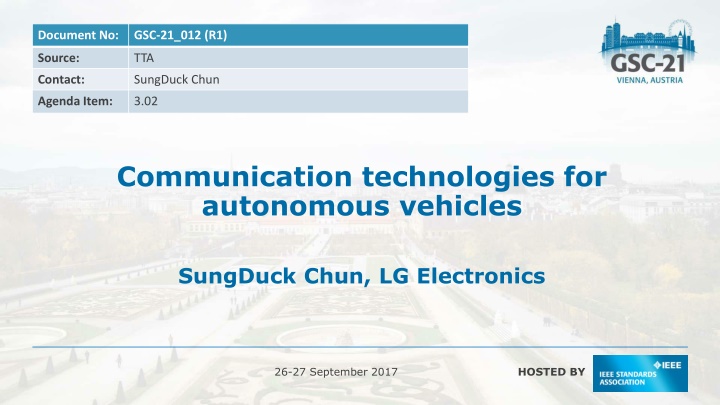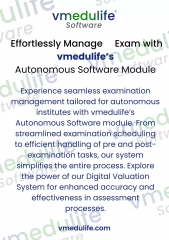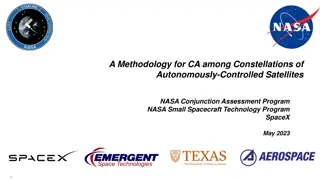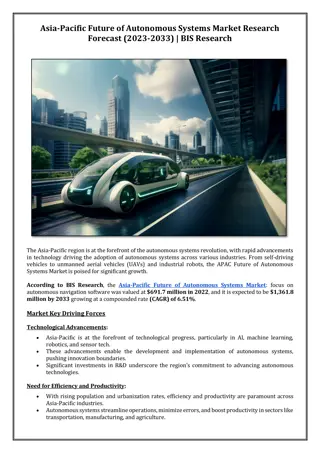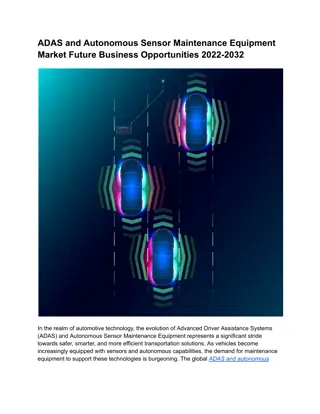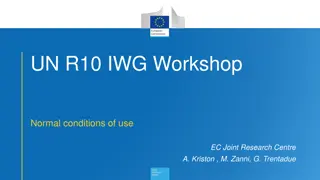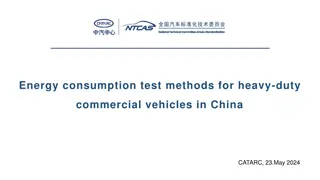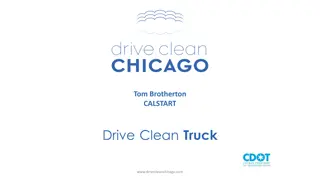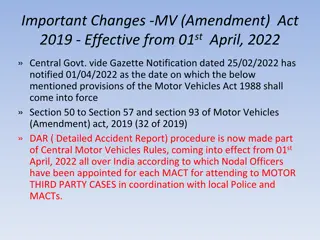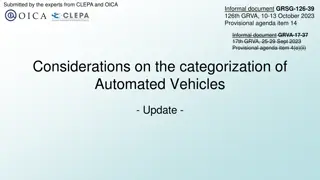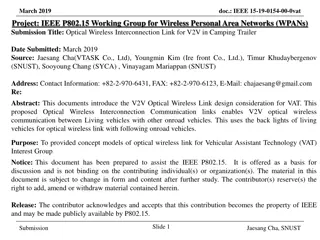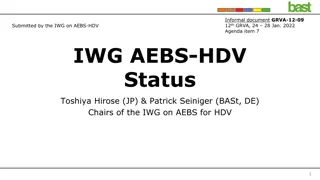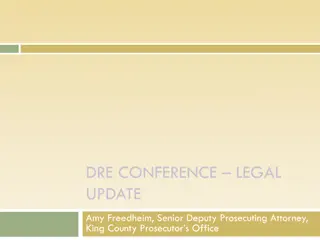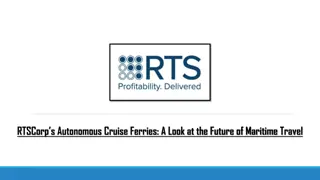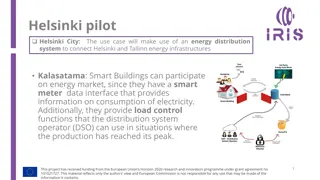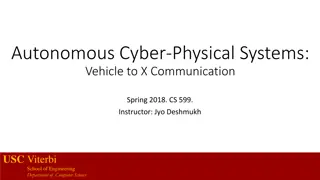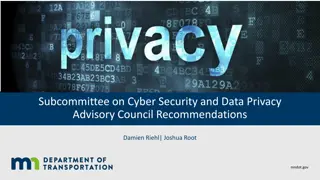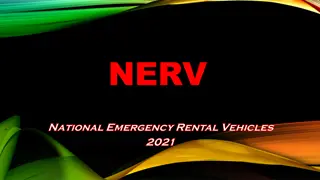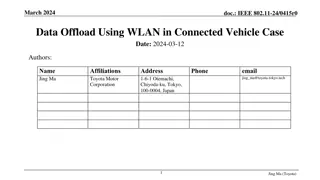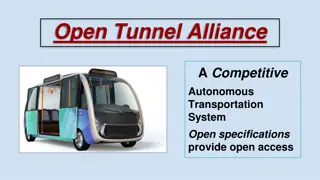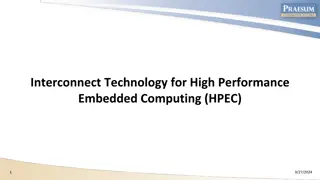Communication Technologies for Autonomous Vehicles
This presentation delves into various aspects of autonomous vehicles, including levels of autonomous driving, the role of communication, standardization activities of C-V2X, and examples of sensor limitations. It discusses the elements needed to advance autonomous driving levels and the significance of communication technologies in enhancing vehicle autonomy.
Download Presentation

Please find below an Image/Link to download the presentation.
The content on the website is provided AS IS for your information and personal use only. It may not be sold, licensed, or shared on other websites without obtaining consent from the author.If you encounter any issues during the download, it is possible that the publisher has removed the file from their server.
You are allowed to download the files provided on this website for personal or commercial use, subject to the condition that they are used lawfully. All files are the property of their respective owners.
The content on the website is provided AS IS for your information and personal use only. It may not be sold, licensed, or shared on other websites without obtaining consent from the author.
E N D
Presentation Transcript
Document No: GSC-21_012 (R1) Source: TTA Contact: SungDuck Chun Agenda Item: 3.02 Communication technologies for autonomous vehicles SungDuck Chun, LG Electronics 26-27 September 2017 HOSTED BY
Topics in this presentation Introduction to autonomous vehicles The role of communication in autonomous vehicles Standardization activities of C-V2X Performance of C-V2X Topics for discussion 26-27 September 2017 26-27 September 2017 Pg 2 |
Levels of autonomous driving There are multiple levels for autonomous vehicles Level 1 Level 2 Partial Level 3 Conditional Level 4 High Level 5 Driver Assistance Full automation Driving assistance by using either steering or braking/ acceleration Driver assistance by combining multiple operation simultaneously (e.g. by steering control while accelerating) Driving control with assumption that drivers can intervene when requested Driving control even if drivers can not react immediately Not applicable to all scenarios (e.g. highway driving, parking) Driving control even if drivers can not react immediately Applicable full-time Overview Assist drivers attention Assist driver with basic repetitive operations Assist driver by doing some operations such as lane changing. Burden on the driver can be reduced Drivers may do other tasks as long as drivers can take control when requested by driving system In certain scenario, driver can do other tasks Efficient use of time by drivers Drivers can always do other tasks than driving Reduced traffic jam Operation efficiency of vehicles maximized Benefit 26-27 September 2017 26-27 September 2017 Pg 3 |
Elements to the next levels There are multiple levels for autonomous vehicles Level 5 Human-based driving System-based driving Level 4 Level 3 Fully covered high definition map (e.g. even parking area) Dynamic map update (e.g. event-triggered map update) Reliability enhancement in sensing/decision/control (to support even eye-off) Infra-structure assistance (e.g. old vehicles, pedestrians) Understanding of other vehicle (e.g. behavior on curved road, or future trajectory) Cloud computing, artificial intelligence High definition positioning High definition map (exit, merge, intersection, etc.) Sensing non-visible area (e.g. during overtaking) Level 2 Advance in sensor technologies Sensor fusion Combination of multiple operations Level 1 26-27 September 2017 26-27 September 2017 Pg 4 |
Examples of limitation in case of sensors only 1 3 2 HV Sensors don t know when/whether other vehicles will change lanes. 1 Sensors may not detect this vehicle which is not in line-of- sight. 2 Sensors cannot know whether lane change is happening or the vehicle is moving on curved road. 3 4 Sensors don t know which route should be avoided 4 26-27 September 2017 26-27 September 2017 Pg 5 |
Then, what communication can do I will change lane X seconds later 1 I m on the curved road I m here 3 2 HV Communication can deliver information beyond what sensors can detect. E.g.: Status information (speed, location, heading, etc.) of each vehicle, even if it is not in line-of-sight Intention information (future planned trajectories, negotiation of future movement) Shared awareness (information exchange of detected objects, other events such as roadwork) Road work at location K 4 26-27 September 2017 26-27 September 2017 Pg 6 |
Or, even cloud computing can be supported While hardware installed in a vehicle may not be upgraded, artificial intelligence in the cloud will continuously evolve. As long as communication path is available between vehicle and A.I. in the cloud, new and advanced service can be provided to a old vehicle. Image processing to calculate position, to identify objects Coordination of future trajectories of vehicles Planning of future route Remote driving control of vehicle A.I. in the cloud 26-27 September 2017 26-27 September 2017 Pg 7 |
Roadmap of Cellular V2X 3GPP finished the first phase of C-V2X and has moved into next phases (SA1) LTE V2X (`15.02~ `16.03) Stage-1 Use case, Requirements (SA1) eV2X (`16.05~ `17.03) (SA2) LTE V2X (`15.10~ `16.09) Stage-2 Architecture (SA2) eV2X (`17.04~ `18.09) (RAN) LTE V2X (`15.06~ `17.03) Stage-3 Protocols (RAN) LTE eV2X (`17.04~ `18.06) (RAN) NR eV2X (`17.3Q~ `19.4Q) Basic V2X services Advanced V2X services Road hazard warning Intersection movement assistance Forward collision warning Autonomous driving CACC, Platooning Tele-operated driving Sensor data sharing -> Higher reliability, Higher throughput, Lower latency 26-27 September 2017 Pg 8 |
Topics for discussion Standardization of V2X Applications for beyond Day 2: For some advanced V2X applications, progress of standardization is slow. For other advanced V2X applications, there is no plan at all. (e.g. video sharing, remote driving, etc.) Cloud-to-cloud connectivity between stake-holders also needs to be considered. (e.g. how one OEM cloud connects to other OEMs cloud? how operators cloud connects to other OEMs cloud or operators cloud?) Coexistence and evolution ITS band (e.g. 5.9 Ghz) is technology neutral, allowing access of both C-V2X and DSRC/ITS-G5. How to ensure coexistence of both technologies within same band? How to ensure the evolution of access technologies? What and to which extent interoperability should be supported? Competition and collaboration Which part of V2X service is up for competition/implementation and which part of V2X service is up for collaboration/standardization? Which part of V2X specification is up for competition or collaboration among SDOs? 26-27 September 2017 Pg 9 |
Annex A: Evolution of Cellular technologies Cellular technologies are merging, what about V2X? 2G 3G 4G EDGE GSM/GPRS WCDMA/HSxPA LTE- Pro LTE LTE-A CDMA2000 1x, EV-DO, Rev A/B IS-95A/B 26-27 September 2017 Pg 10 |
Annex B: Evolution of IMS Standardization IMS specification also converged, then what about V2X? Pre 3GPP Release 6 3GPP Release 9 3GPP Release 8 3GPP Release 6 3GPP Release 7 Common IMS (i.e. Access agnostic) Specs Common IMS Specs 3GPP IMS Specs Common IMS Specs Common IMS Specs 3GPP 3GPP2 TISPAN IMS Release-1 specs IMS Release-2 specs MMD specs 26-27 September 2017 Pg 11 |
Annex C: Co-existence example 5GAA s approach on co-existence 26-27 September 2017 Pg 12 |
Thank you For more information, please contact: Sungduck Chun sungduck.chun@lge.com Affiliation Name: www.lge.com 26-27 September 2017 Pg 13 |
